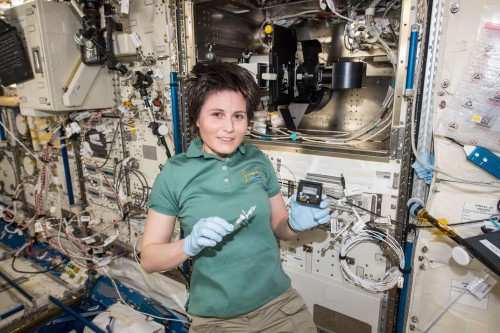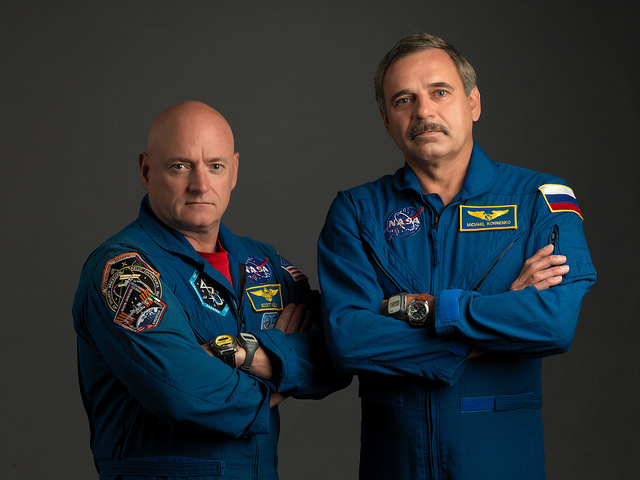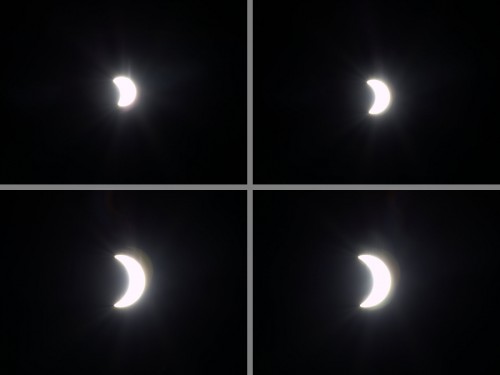
SPACE STATION WEEKLY UPDATE March 16 – March 22, 2015 — Over the last two weeks, the International Space Station (ISS) saw the end of one expedition and the beginning of another when Expedition 42 Commander Barry “Butch” Wilmore handed station control over to Expedition 43 Commander (and NASA astronaut) Terry Virts. With the departure of Expedition 42, Expedition 43 resumed ongoing science and research last week, while new crew members on the ground continued with preparations for launch from Russia later this week.
Expedition 42 concluded with the return of three of its crew, NASA astronaut Barry “Butch” Wilmore and Russian cosmonauts Elena Serova and Alexander Samokutyaev, on March 12, 2015. They were sent home with microorganism samples and radiation detectors from the ISS for further study, to assist researchers in creating a healthy and safe environment for humans living both in space and on Earth.

A set of microbial samples taken from surfaces around the ISS by cosmonaut Anton Shkaplerov, prior to the departure of the crew, was sent back with them as part of the return cargo. These samples are part of the RJR Augmented Microbial Sampling study. Now that they are returned to Earth, they will be examined by researchers.
Due to the microbes’ ability to exist in any environment, and since microbial contamination is not always completely preventable, despite the best efforts to sanitize spaceflight vehicles and cargo before they are sent into space, it is important to gain insight into how and where they grow on the ISS. In a closed environment such as the ISS, microbes can pose a threat to system performance, vehicle integrity, and health of the astronauts living aboard.
The RJR Augmented Microbial Sampling investigation will peer into the behavior of microbes aboard the ISS. Researchers will determine the areas on the space station where microbes are most likely to grow, regardless of the amount of decontamination of spacecraft and cargo that takes place. Future spacecraft and the ISS will benefit from this study, as the data will serve as a foundation for making future decisions about how to handle monitoring the microbes and how to reduce the amount that actually do exist. One way they may be controlled is through stronger cleaning protocols for areas on the station identified as contamination “hotspots” after heavier monitoring once identified. The information learned from this study could also have use on Earth, as it could lead to more knowledge about how microorganisms behave in different environments like office buildings, hospital rooms, and a variety of other environments where humans routinely populate.
Other scientific cargo returned with the Expedition 42 departing crew members included the passive detector packs for the Dose Distribution Inside the International Space Station- 3D (DOSIS-3D) investigation. European Space Agency astronaut Samantha Cristoforetti gathered the packs, which was the sixth set collected, to return and make room for the installation of a new set scheduled to arrive with the new One-Year mission crew members upcoming launch to the station.

Astronauts are routinely exposed to different levels of radiation that can affect their bodies. The active and passive detectors used in the DOSIS-3D study measure the doses of the radiation that occur on the space station. The ESA study aims to create a three-dimensional radiation map which will show the radiation field inside the station—where it occurs and is most prevalent.
DOSIS-3D will help scientists understand how to combine devices for increased dosage monitoring. Additionally, it will allow them to learn how real-time data can be followed. Flight crews and nuclear plant workers on Earth are regularly exposed to higher than normal levels of radiation. This study may provide crucial radiation monitoring information that will benefit commercial and military airline crews, along with any worker that is exposed to radiation on an ongoing basis.
As part of regular ISS experiment upkeep, Cristoforetti also worked on collecting the sample for the ninth run of the Aniso Tubule experiment from the Cell Biology Experiment Facility (CBEF) on the ISS. She placed it under the Aquatic Habitat microscope for further observation by the Japan Aerospace Exploration Agency (JAXA), who then advised her when it was successfully completed.

The goal of the Aniso Tubule study is to gain an understanding as to the mechanisms plants use to create stems that have the correct thickness to support their weight against gravity. In hypergravity, the plant’s microtubules adjust to the local gravity field, forcing them to form short, thick bodies. For this investigation, the Arabidopsis hypocotyls (thale cress) plant will be germinated in space to be further analyzed with a fluorescence microscope in the station’s Kibo module so that the directions the tubules follow in the stem below the seeds of the seedlings may be further observed.
If researchers can better comprehend how large or small a role gravity plays in determining the direction the microtubules follow and how protein expression influences plant growth, they may be able to create better versions of food and other plants that are currently grown on Earth. A large amount of energy in a plant is used to shape the supporting stalks. It may be possible to direct this energy toward an enhanced crop production.
On March 20, 2015, Cristoforetti captured photos of a solar eclipse as the ISS circled the globe. While back on Earth, viewers in select areas were lucky enough to witness the event, but the residents aboard the ISS had front-row seats as they orbited the planet.
On the operations side of the space station, three new residents will be delivered this week. Back on Earth, members that will join the current crew on the ISS for Expedition 43 continued with preparations for their upcoming launch on March 27. Soyuz Commander (and Russian cosmonaut) Gennady Padalka will join the current crew until Sept. 11, 2015, while NASA astronaut Scott Kelly and cosmonaut Mikhail Kornienko will stay aboard the ISS for one year until March 2016 for the One-Year crew study.
In preparation for the new crew’s arrival, the ISS was given an orbital boost last Wednesday evening when the ISS Progress 58 spacecraft, which is currently attached to the Zvezda service module, fired its engines for four minutes and 18 seconds so that it will be in the correct place when the Soyuz spacecraft arrives for docking.
Want to keep up-to-date with all things space? Be sure to “Like” AmericaSpace on Facebook and follow us on Twitter: @AmericaSpace



